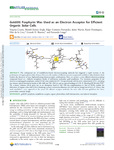Gold(III) Porphyrin Was Used as an Electron Acceptor for Efficient Organic Solar Cells

Use this link to cite
http://hdl.handle.net/2183/30753Collections
- Investigación (EPEF) [590]
Metadata
Show full item recordTitle
Gold(III) Porphyrin Was Used as an Electron Acceptor for Efficient Organic Solar CellsAuthor(s)
Date
2022-02-23Citation
CUESTA, V., et al. Gold(III) Porphyrin Was Used as an Electron Acceptor for Efficient Organic Solar Cells. ACS Applied Materials & Interfaces, -03-09, 2022, vol. 14, no. 9, pp. 11708-11717. ISSN 1944-8244. DOI 10.1021/acsami.1c22813. Disponible en: https://doi.org/10.1021/acsami.1c22813
Abstract
[Abstract] The widespread use of nonfullerene-based electron-accepting materials has triggered a rapid increase in the performance of organic photovoltaic devices. However, the number of efficient acceptor compounds available is rather limited, which hinders the discovery of new, high-performing donor:acceptor combinations. Here, we present a new, efficient electron-accepting compound based on a hitherto unexplored family of well-known molecules: gold porphyrins. The electronic properties of our electron-accepting gold porphyrin, named VC10, were studied by UV−Vis spectroscopy and by cyclic voltammetry (CV) , revealing two intense optical absorption bands at 500−600 and 700−920 nm and an optical bandgap of 1.39 eV. Blending VC10 with PTB7-Th, a donor polymer, which gives rise to an absorption band at 550−780 nm complementary to that of VC10, enables the
fabrication of organic solar cells (OSCs) featuring a power conversion efficiency of 9.24% and an energy loss of 0.52 eV. Hence, this work establishes a new approach in the search for efficient acceptor molecules for solar cells and new guidelines for future
photovoltaic material design
Keywords
Gold (III) porphyrin
Nonfullerene acceptor
Organic photovoltaics
Bulk heterojunction
Near-infrared absorption
Nonfullerene acceptor
Organic photovoltaics
Bulk heterojunction
Near-infrared absorption
Editor version
Rights
Attribution 4.0 International
ISSN
1944-8244






